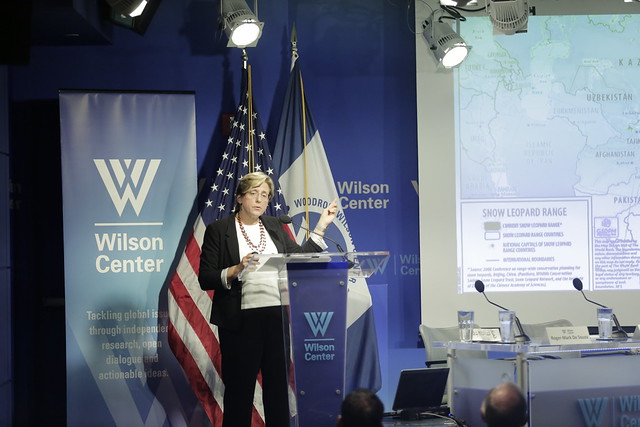-
Thermometers of Change: Snow Leopard Diplomacy in Asia’s High Mountains
November 15, 2017 By Julianne Liebenguth
“Change is everywhere where snow leopards live,” said World Wildlife Fund (WWF) Vice President Kate Newman at a recent Wilson Center event. “The life of the snow leopard is intimately intertwined with the lives of the people in these high mountains,” she said. If you care about water security and climate resilience in Asia, you should also care about the integrity of the snow leopard’s habitat, added Koustubh Sharma of the Snow Leopard Trust. These beautiful and enigmatic animals are “the thermometers of the health of these ecosystems.”
Change in Asia’s High Mountains
Asia’s high mountain ecosystems provide critical resources for many people in the region, including fresh water for almost a third of the world’s population. This vital landscape spans three million square miles and encompasses high elevation glaciers, land that is seasonally snow covered, and five major river basins, said Richard Armstrong, the principal investigator for a USAID-funded project known as CHARIS (“Contribution to High Asia Runoff from Ice and Snow”).
Working with regional universities and institutes, the CHARIS project uses remote sensing technology to estimate patterns of snow and ice melt in the Himalaya, Karakoram, Hindu Kush, Pamir, and Tien Shan mountain ranges.. Modeling the volume and timing of runoff from the mountains can help predict future vulnerabilities for downstream irrigation, hydropower, and drinking water, said Armstrong. “We can’t look at possible future scenarios unless we have a better idea of local and current conditions.”
“With increased global warming, obviously things will change”Asia’s high elevation glaciers are generally stable under the current climate, “but with increased global warming, obviously things will change,” said Armstrong. Already, other effects of environmental change—including grassland degradation, changing monsoon patterns, and rising temperatures—are generating significant challenges for the countries and communities that rely upon the mountain ecosystems for food and water security.
An Unlikely Ambassador: Snow Leopard Conservation Builds Cooperation
The snow leopard’s habitat stretches across 12 countries within Asia’s high mountain terrain, some of which are entangled in long-standing political disputes, like India and Pakistan. “Protecting the snow leopard is almost impossible” without transboundary cooperation across states, said Ghana Gurung, the senior conservation program director at WWF Nepal. The snow leopard can act as an “ambassador” by bringing together countries that don’t normally engage in diplomatic conversations to cooperate on conserving it.
The Global Snow Leopard Ecosystem Protection Program (GSLEP) provides a political platform through which representatives from the 12 snow leopard countries—as well as researchers, conservationists, and international organizations—can come together to discuss sustainable development and snow leopard conservation, said Koustubh Sharma, who is the international coordinator for GSLEP. “These people included business leaders from some of the biggest industries, who are otherwise seen on the other side of the fence when we talk [about] wildlife conservation,” said Sharma.
“Protecting the snow leopard is almost impossible” without transboundary cooperationUnder the GLSEP program, the countries, plus other partner institutions, have committed to protecting 23 landscapes across the high mountains of Asia that are critical to the snow leopard’s survival. The implementation process includes developing country-specific natural resource plans, scaling up local knowledge, and building agency within communities in the region.
The GSLEP program is “the only platform in the whole world where these 12 countries come together and agree upon issues related to snow leopard conservation,” said Sharma. Representatives from both India and Pakistan, for instance, endorsed the 2017 Bishkek Declaration—which outlines shared conservation objectives and principles—during the Second International Forum on Snow Leopard and Ecosystem Conservation in Bishkek, Kyrgyzstan, this August.
Human-Environment Co-Benefits: A Quadruple Win for Communities
“It’s not all about ecology of conservation for snow leopards; it’s about community,” said Gurung, who grew up as a herder in the mountains of Nepal where snow leopards threatened his family’s livestock. But Gurung, who has since come to appreciate the value of the snow leopard as an umbrella species, has dedicated his career to strengthening both snow leopard conservation and capacity building across Asia’s high mountain communities.
WWF’s snow leopard conservation project protects the lives of mountain people through site-specific initiatives that preserve ecosystems and empower local community members. Nepal’s Snow Leopard and Ecosystem Management Plan, for instance, trains grassland herders as citizen scientists so they can track snow leopard behavior, understand climate change impacts, and ultimately increase resilience among communities. Other WWF initiatives include diversifying livelihoods and developing insurance schemes to cover the cost of livestock killed by snow leopards.
USAID’s focus on co-benefits gave them a “quadruple win,” said Mary Melnyk, the environmental security and resilience team leader for USAID’s Asia Bureau. “We worked to save an endangered species; we worked to improve the lives of mountain people; we worked with them to protect life-giving streams and rivers, and…we helped establish a platform to enhance regional cooperation.” In moving forward, said Melynk, “let’s remember how one iconic species can do so much.”
Event Resources
- Event Video
- Event Photos
- Richard Armstrong Presentation
- Ghana Gurung Presentation
- Mary Melnyk Presentation
- Kate Newman Presentation
- Koustubh Sharma Presentation
Sources: Global Snow Leopard & Ecosystem Protection Program, Mountain Partnership, National Snow and Ice Data Center, United States Agency for International Development, World Wildlife Fund
Photo Credit: Snow leopard, January 2013, courtesy of USAID Afghanistan.
 A Publication of the Stimson Center.
A Publication of the Stimson Center.








